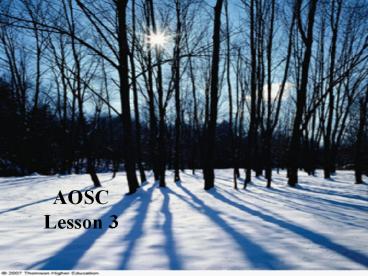AOSC Lesson 3 - PowerPoint PPT Presentation
Title:
AOSC Lesson 3
Description:
(3) advection (4) transfer of radiation (5) latent heat of ... ADVECTION. Transfer of Energy in the Atmosphere. CONDUCTION. TRANSFER OF ENERGY THROUGH MATTER ... – PowerPoint PPT presentation
Number of Views:27
Avg rating:3.0/5.0
Title: AOSC Lesson 3
1
AOSCLesson 3
2
Temperature Scales
- Temperature scales are defined by upper and lower
calibration points (fixed points) - In the Fahrenheit temperature scale the lower
fixed point of 0F is defined as the temperature
of a mixture of salt and ice. - Dr. Fahrenheit was a physician, and he defined
the upper fixed point, 100F, as the average
temperature of his (sick?) patients. - In the Centigrade (Celsius) scale, the lower
fixed point, 0C, is defined as the temperature
of the melting point of ice, while the upper
fixed point, 100C, is defined as the boiling
point of water. - The Kelvin scale is a scientific scale. Here the
lowest fixed point 0K is defined as the
theoretically lowest temperature that can be
reached. On this scale the melting point of ice
is about 273K. One degree K one degree C.
3
Fig. 2-1, p. 29
4
Specific Heat
Table 2-1, p. 30
5
How is energy transferred in the atmosphere?
- Tornados, Hurricanes, Severe Storms all require a
large energy source. - All of this energy comes from the Sun.
- So, how is this energy transferred within the
atmosphere? - Five major processes,
- (1) conduction
- (2) convection
- (3) advection
- (4) transfer of radiation
- (5) latent heat of vaporization of water
6
CONDUCTION
Fig. 2-2, p. 30
7
(No Transcript)
8
CONVECTION
Fig. 2-3, p. 31
9
ADVECTION
Fig. 2-4, p. 31
10
Transfer of Energy in the Atmosphere
- CONDUCTION
- TRANSFER OF ENERGY THROUGH MATTER
- AIR IS A POOR CONDUCTOR
- ONLY IMPORTANT AT THE EARTH'S SURFACE
- CONVECTION
- TRANSFER OF ENERGY BY MOVEMENT OF MASS
- CAN ONLY TAKE PLACE IN LIQUIDS IN
SCIENTIFIC TERMS AIR IS A LIQUID. - ENERGY ACQUIRED AT SURFACE OF EARTH IS
TRANSPORTED UPWARD BY CONVECTIVE FLOW - CONVECTION ON A GLOBAL SCALE CREATES
WORLDWIDE ATMOSPHERIC CIRCULATION - ADVECTION
- HORIZONTAL MOVEMENT OF AIR
11
PHASE CHANGES OF WATER
Fig. 2-5, p. 33
12
Latent heat Changing the Phase of Water
- LATENT HEAT IS THE HEAT ABSORBED OR RELEASED BY
UNIT MASS OF WATER WHEN IT CHANGES PHASE. - LATENT HEAT OF MELTING / FUSION
- LATENT OF VAPORIZATION / CONDENSATION
- LATENT HEAT OF SUBLIMATION / DEPOSITION
- THIS GIVES US ANOTHER WAY OF TRANSFERRING ENERGY
IN THE ATMOSPHERE - THE OCEANS ABSORB SOLAR ENERGY TO EVAPORATE WATER
VAPOR. - THE WATER VAPOR IS TRANSPORTED BY WINDS ETC
- WHEN THE WATER VAPOR CONDENSES TO FORM CLOUDS THE
LATENT HEAT IS RELEASED. - THE LATENT HEAT RELEASED IS THE SOURCE OF ENERGY
THAT DRIVES SEVERE WEATHER, E.G. HURRICANES.
13
Radiation
Energy is transferred to the Earth from the sum
by electromagnetic waves. Other examples of
electromagnetic waves are microwave and radio
waves.
Each wave is characterized by a wavelength(the
distance between successive peaks) and a
frequency ( the number of peaks that pass by per
second)
Fig. 2-6, p. 34
14
ELECTROMAGNETIC SPECTRUM
Fig. 2-7, p. 34
15
Laws of Radiation
Wiens Displacement Law
Stephan-Boltzmann Law
16
All things emit thermal radiation. This is a
picture of a person holding a match. It was taken
with a camera sensitive to infrared radiation.
Fig. 2.11
17
Note that the peak of the Earths radiation
occurs at 10 ?m while that for then sun is at 0.5
?m, a ratio of 20. The ratio of the temperatures
is 1/20. (Wiens Displacement Law)
Fig. 2-8, p. 36
18
- SEVERAL QUESTIONS
- WHY DOES THE EARTH HAVE SEASONS?
- WHY ARE THE POLES COLD YET THE EQUATOR IS HOT?
- WHY IS DAYLIGHT LONGER IN THE SUMMER THAN IN THE
WINTER?
19
(No Transcript)
20
(No Transcript)
21
Fig. 2-14, p. 43
22
Fig. 2-11, p. 41
23
HEATING OF THE EARTHS SURFACE DEPENDS ON THE
AMOUNT OF SOLAR RADIATION PER UNIT AREA. SAME
AMOUNT OF RADIATION IS DISTRIBUTED OVER A LARGER
AREA IN A THAN IN B. RADIATION PER UNIT AREA IS
LESS IN A THAN IN B. LESS HEATING IN A THAN IN B.
Fig. 2-12, p. 42
24
Fig. 2.15

